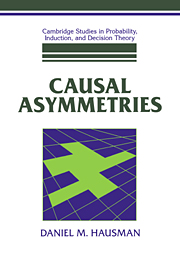Book contents
- Frontmatter
- Contents
- List of Figures
- Acknowledgments
- Introduction: Causation and its Asymmetries
- 1 Metaphysical Pictures and Wishes
- 1* Transfer Theories
- 2 Is Causation a Relation Among Events?
- 3 Causation, Regularities, and Time: Hume's Theory
- 4 Causation and Independence
- 4* Causation, Independence, and Causal Connection
- 5 Agency Theory
- 5* Causal Generalizations and Agency
- 6 The Counterfactual Theory
- 6* Independence and Counterfactual Dependence
- 7 Counterfactuals, Agency, and Independence
- 7* Agency, Counterfactuals, and Independence
- 8 Causation, Explanation, and Laws
- 8* Causation, Explanation, and Independent Alterability
- 9 Probabilistic Causation
- 10 Causation and Conditional Probabilities
- 10* Causal Graphs and Conditional Probabilistic Dependencies
- 11 Intervention, Robustness, and Probabilistic Dependence
- 11* Interventions and Conditional Probabilities
- 12 Operationalizing and Revising the Independence Theory
- 12* Probability Distributions and Causation
- 13 Complications and Conclusions
- Appendix A Alphabetical List of Propositions
- Appendix B List of Theorems
- References
- Index
8* - Causation, Explanation, and Independent Alterability
Published online by Cambridge University Press: 20 April 2010
- Frontmatter
- Contents
- List of Figures
- Acknowledgments
- Introduction: Causation and its Asymmetries
- 1 Metaphysical Pictures and Wishes
- 1* Transfer Theories
- 2 Is Causation a Relation Among Events?
- 3 Causation, Regularities, and Time: Hume's Theory
- 4 Causation and Independence
- 4* Causation, Independence, and Causal Connection
- 5 Agency Theory
- 5* Causal Generalizations and Agency
- 6 The Counterfactual Theory
- 6* Independence and Counterfactual Dependence
- 7 Counterfactuals, Agency, and Independence
- 7* Agency, Counterfactuals, and Independence
- 8 Causation, Explanation, and Laws
- 8* Causation, Explanation, and Independent Alterability
- 9 Probabilistic Causation
- 10 Causation and Conditional Probabilities
- 10* Causal Graphs and Conditional Probabilistic Dependencies
- 11 Intervention, Robustness, and Probabilistic Dependence
- 11* Interventions and Conditional Probabilities
- 12 Operationalizing and Revising the Independence Theory
- 12* Probability Distributions and Causation
- 13 Complications and Conclusions
- Appendix A Alphabetical List of Propositions
- Appendix B List of Theorems
- References
- Index
Summary
The first two sections consider whether there is any way to strengthen the DN model to deal with the problem cases without relying on the notion of causation or on elements of a nonconditional analysis of causation. The third section provides proofs underlying the conclusions drawn in §8.5.
Nomic Sufficient Conditions and Explanations
In his essay “The Direction of Causation and the Direction of Conditionship” David Sanford offers an account of causal priority in terms of a nonsymmetrical relation among propositions, “is a causal condition of.” If his account succeeds, then he has provided the core of a purely conditional analysis of causation. Sanford also implicitly offers an account of scientific explanation. Sanford does not claim to have done so much, because his account also relies on an unanalyzed notion of “causal connection in a direct line.”
Let us, following Sanford, say that “A is nomically sufficient for B in circumstances C” (or “B is nomically necessary for A in circumstances C”) if and only if “A&∼B&C&L” is logically inconsistent where A, B, C, and L are all propositions, the conjunction is strongly nonredundant, and L is a (conjunction of) law(s) of nature. A and B state that events with properties A and B occur (1976, pp. 200–1). The exposition differs here from Sanford's in four significant ways: (1) Sanford's exposition is more general and applies to other sorts of necessity. (2) Sanford uses the notion of a logical impossibility rather than the narrower one of logical inconsistency.
- Type
- Chapter
- Information
- Causal Asymmetries , pp. 176 - 184Publisher: Cambridge University PressPrint publication year: 1998



